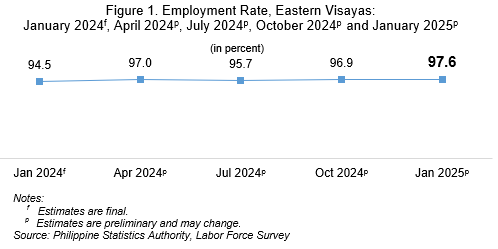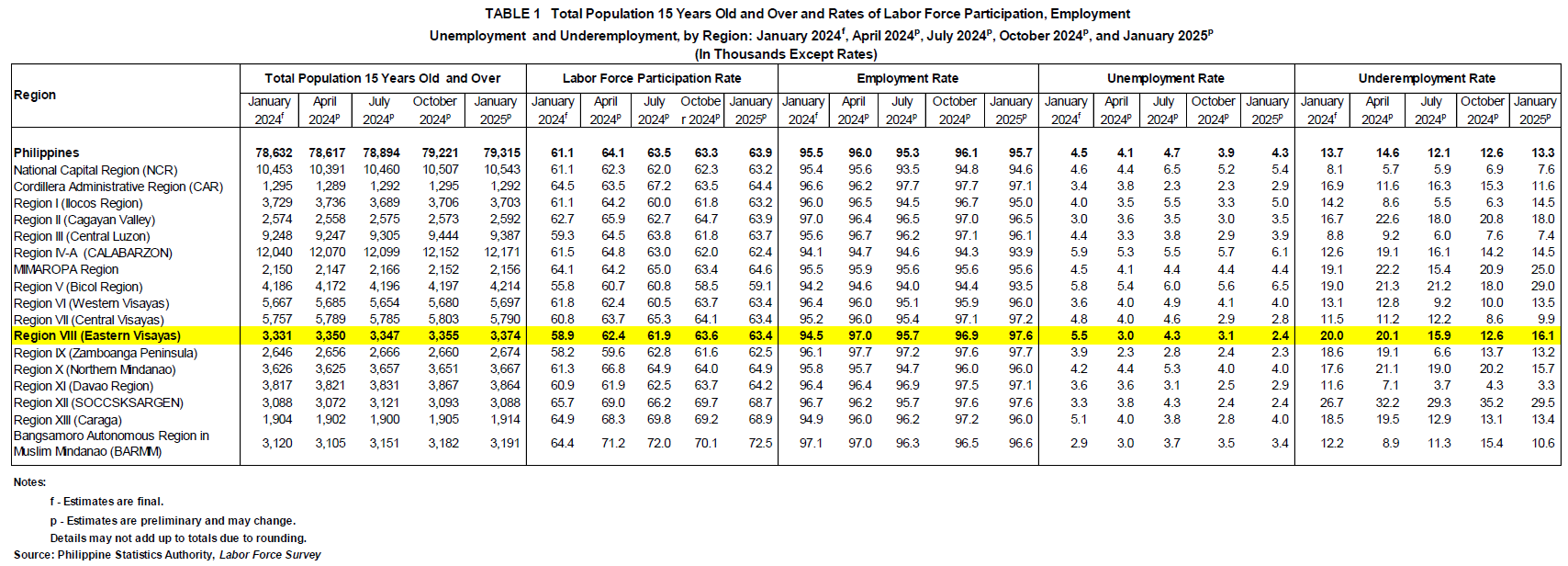
The employment rate in Eastern Visayas increased to 97.6 percent in January 2025, from 94.5 percent in January 2024 and 96.9 percent in October 2024. This employment rate translates to 2.09 million employed persons out of the 2.14 million persons in the labor force in January 2025. The number of employed persons in January 2025 was higher by about 231 thousand compared with the 1.86 million employed persons in January 2024. This was higher by 19 thousand than the 2.07 million employed persons in October 2024 (Figure 1 and Table 1).
Consequently, the region’s unemployment rate decreased to 2.4 percent in January 2025, from 5.5 percent in January 2024 and 3.1 percent in October 2024. The unemployment rate in January 2025 translates to about 52 thousand unemployed persons out of the 2.14 million persons in the labor force in January 2025. The number of unemployed persons in January 2024 was at 107 thousand, while in October 2024 was at 66 thousand.
Meanwhile, the underemployment rate in January 2025 was posted at 16.1 percent. This means that out of the 2.09 million employed persons in January 2025, there were about 335 thousand employed persons who expressed the desire to have additional hours of work in their present job or to have an additional job, or to have a new job with longer hours of work.
Eastern Visayas registered a Labor Force Participation Rate (LFPR) of 63.4 percent in January 2025. This placed the region’s labor force at 2.14 million persons who were either employed or unemployed out of the estimated 3.37 million population 15 years old and over in January 2025.
SGD. WILMA A. PERANTE
Regional Director

Technical Notes
The stability and growth of a country’s economy hinges on its ability to produce goods and services for both domestic and international use. Labor represents an important factor of production, hence, the improvement of the quality of the labor force, and efforts to make it more productive and responsive to growth are necessary for the development of the economy. A clear knowledge and understanding of the size, composition, and other characteristics of the segment of the population is a big step in this direction. A continuing supply of the data on labor force is indispensable to national and local development planning. The Labor Force Survey (LFS) gathers data on the demographic and socio-economic characteristics of the population with nationwide coverage and conducted quarterly and monthly by interviewing households.
The LFS aims to provide a quantitative framework for the preparation of plans, and formulation of policies affecting the labor market. The survey is designed to provide statistics on levels and trends of employment, unemployment, and underemployment for the country, as a whole, and for each of the administrative regions.
With regions as domain, survey operations for January 2025 LFS ran from 08 to 31 January 2025 and covered 2,688 effective sample households in the region. The sampling frame used was the 2023 Geo-enabled Master Sample (GeoMS) design for household-based surveys. The 2023 GeoMS is constructed based on the results of the 2020 Census of Population and Housing (2020 CPH). Computer Aided Field Editing (CAFE) program was used to ensure completeness and consistency of encoded entries. The reference period for this survey is the “past week” referring to the past seven (7) days preceding the date of visit of the enumerator or the interviewer.
“Population 15 Years Old and Over” refers to the number of population 15 years old and over excluding overseas workers. “In the Labor Force” or “Economically Active Population” refers to persons 15 years old and over who are either employed or unemployed in accordance with the following definitions:
Employed persons include all those who, during the reference period are 15 years old and over as of their last birthday, and are reported either:
a. At work, i.e., those who do any work even for one hour during the reference period for pay or profit, or work without pay on the farm or business enterprise operated by a member of the same household related by blood, marriage, or adoption; or
b. With a job but not at work, i.e., those who have a job or business but are not at work because of temporary illness or injury, vacation, or other reasons. Likewise, persons who expect to report for work or to start operation of a farm or business enterprise within two weeks from the date of the enumerator’s visit are considered employed.
Underemployed persons include all employed persons who express the desire to have additional hours of work in their present job, or an additional job, or to have a new job with longer working hours. Visibly underemployed persons are those who work for less than 40 hours during the reference period and want additional hours of work.
Unemployed persons include all those who, during the reference period, are 15 years old and over as of their last birthday, and reported as persons:
a. Without work, i.e., had no job or business during the reference period;
b. Currently available for work, i.e., were available and willing to take up work in paid employment or self-employment during the reference period, and/or would be available and willing to take up work in paid employment or self-employment within two weeks after the interview date; and
c. Seeking work, i.e., had taken specific steps to look for a job or establish a business during the reference period, or
d. Not seeking work due to the following reasons: (1) fatigued or believed no work available, i.e., discouraged workers; (2) awaiting results of previous job application; (3) temporary illness or disability; (4) bad weather; and/or (5) waiting for rehire or job recall.Persons Not in the Labor Force are persons 15 years old and over who are neither employed nor unemployed according to the definitions mentioned. Those not in the labor force are persons who are not looking for work because of reasons such as housekeeping, schooling and permanent disability. Examples are housewives, students, persons with disability, or retired persons.
SGD. WILMA A. PERANTE
Regional Director

